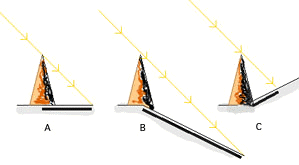 Figure 1.
Effect
of Slope on shadow length of an object. Direction of sunlight indicated
by yellow lines, and the shadows cast by thick black lines.
Figure 1.
Effect
of Slope on shadow length of an object. Direction of sunlight indicated
by yellow lines, and the shadows cast by thick black lines.
 Figure 1.
Effect
of Slope on shadow length of an object. Direction of sunlight indicated
by yellow lines, and the shadows cast by thick black lines.
Figure 1.
Effect
of Slope on shadow length of an object. Direction of sunlight indicated
by yellow lines, and the shadows cast by thick black lines.
A. Zero slope. tan(45) = 1.0, and the length of the shadow is equal to the object's height.
B. -26 degree slope. tan(45 - 26) = 0.34, and the shadow's length is about 3 times the object's height.
C. +26 degrees slope. tan(45 + 10) = 2.9, and the shadows length is about 1/3 the height of the object. (The shadow is somewhat longer than that here because the object is shown sitting on the horizontal surface, not on the upward sloping surface and tilted toward the sun.)
It is obvious that just knowing the sun's elevation is not enough to determine the height of an object from the length of its shadow; the slope of the surface on which the shadow is being cast must also be known. The official position that the Cuspids are merely boulders depends on the sort of lighting geometry shown in Figure 1B, although the angles are much exaggerated relative to the actual lighting geometry in LO2-61H3. The darkness of the terrain over which the shadow of Cuspid 5 falls (the unusual "Trench") certainly suggests that there is such a slope involved, at least for that object. The bottom of the "trench" probably darker than the surrounding terrain not because it is deep, but because it's surface slopes downward away from the sun.Lighter areas indicate more level slopes, and the lightest features indicate slopes upward in the antisolar direction.
The rule of thumb called Occam's Razor states that the simplest explanation that fits all the known facts of a problem is the most likely. In the case of the Blair Cuspids, this rule has apparently been misconstrued in scientific circles to mean that since the precise sun angles at which the cuspids are illuminated are unknown, it is simplest to attribute the shadows to boulders and extremely low sun angles, forget the whole thing, and call anyone who disagrees a "nut," as one author has unfortunately done. Some scientists seem to habitually mistake the most convenient (for themselves) explanation to be the simplest explanation. While the assertions about a low sun angle may have been the most convenient explanation, it is by no means apparent that it is the simplest. There are three circumstances surrounding this photograph, LO2-61H3, that make things not so simple:
(1) General Terrain of the Area. The Blair Cuspids are at the western-most edge of Mare Tranquillitatus, and the general trend is for the ground to rise toward the western highlands moving from east to west. The countour maps of this region of the moon show that the terrain rises at a slopes as much as 1 or 2 degrees moving west. Because the sun was in the East when LO2-61 was taken, this slope effectively increases the sun's angle above the 10.9 degree elevation by that number of degrees, as in the situation illustrated in Figure 1C, although the upward slope is probably no more than a few degrees and nowhere near the 26 degree slope of the illustration. For any given point on the surface chosen at random, the true angle of solar illumination is as likely to be greater than 12 or 13 degrees as it is to be less. While there could be great variation in slope from one point to another, this general trend makes it less likely that the slopes in the area of the Cuspids are rising toward the east against the general trend in a way that would favor the low-sun angle assertion, and more likely that the terrain is sloping upward in the antisolar direction, the situation illustrated in Figure 1C.
(2) Degree of Illumination of Craters in the Vicinity. There are two well-defined craters in the "trench" that have their western walls illuminated by the sun that can be seen in the previously displayed image the region. The sizes of the crescents of illumated crater wall in proportion to the crater area appear similar to those of other craters illuminated at sun angles of 5 to 15 degrees. While there is much variation due to differences in crater shapes and depths, a crater illuminated at sun angles of less than 5 degrees generally appears as thin a white ring around a black interior circle. Except fo the shallowest of craters, the rim will cast a pointed shadow at very low sun angles. It can be seen that the crater in the upper right-hand corner of the trench casts only a short shadow suggestive of a less-extreme sun angle.
(3) Length of the Penumbral Shadow of Cuspid 5. The tip of the shadow of Cuspid 5 bisects the crater at the lower edge of the trench. Sampling of pixel brightnesses shows that the shadowed region near the tip becomes significantly brighter even though the surrounding unshadowed crater wall becomes darker. This lighter shadowed region must be the penumbral shadow of the Cuspid. Penumbral shadows are cast by objects illuminated by the sun because the sun is not a point source of light; it is a disk whose angular diameter is 0.5 degrees. The reason for penumbral shadowing is illustrated in the diagram in Figure 2 below.
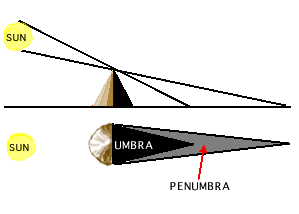 Figure 2.
Diagram showing the geometry giving rise to a penumbral shadow cast by
a conical object. The directions of light rays from the top and bottom
of the sun are indicated by the black lines extending from the sun down
to the surface. At the top of the diagram is a view looking toward the
horizon from the surface. At the bottom is a view of the shadow looking
down at the surface from above. Again, the angles have been greatly exaggerated
for this illustration.
Figure 2.
Diagram showing the geometry giving rise to a penumbral shadow cast by
a conical object. The directions of light rays from the top and bottom
of the sun are indicated by the black lines extending from the sun down
to the surface. At the top of the diagram is a view looking toward the
horizon from the surface. At the bottom is a view of the shadow looking
down at the surface from above. Again, the angles have been greatly exaggerated
for this illustration.
The interesting thing about penumbral shadows is that they can, under some conditions, provide an indirect measure of the angle of the sun's illumination because the length of the penumbra relative to the length of the umbral (inner) shadow varies with the angle of illumination.
For instance, at a sun elevation of 1 degree the umbra's length is 1/tan(1.25) times the object's height while the penumbra ends at a distance of 1/tan(0.75) times the height of the object. The length of the penumbral zone is the difference between those two numbers so that at a 1 degree sun elevation, the distance between the umbral terminator and the penumbral terminator is 67% the length of the umbral shadow. For a sun elevation of 8 degrees, however, the penumbral zone is only 7% the length of the umbra. This difference in the relative size of the umbral and penumbral shadows with illumination angle can be used, at least in theory, to determine what the illumination angle was. The effect of sun angle on the relative sizes of the umbra and penumbra are illustrated below in Figure 3.
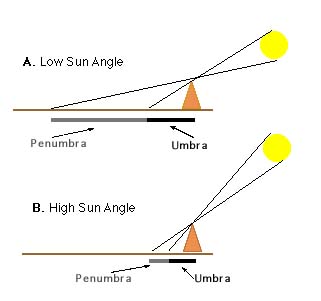 Figure 3.
Effect
of sun elevation on the relative sizes of the penumbra (gray bar) and umbra
(black bar).The sun is represented by the yellow circle.
Figure 3.
Effect
of sun elevation on the relative sizes of the penumbra (gray bar) and umbra
(black bar).The sun is represented by the yellow circle.
The boundaries of a penumbra are inherently fuzzy, and it is likely
that the penumbra would not be discernable at all for a sun elevation of
only 1 degree because the transition from total shadow at the umbral terminator
to full illumination at the penumbral terminator is spread out over a greater
length. But as shown in the enlargement of the shadow's tip in Figure 4below,
the penumbral zone of the shadow from Cuspid 5 is fairly distinct and terminates
at a point just beyond the rim of the crater.
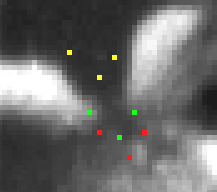 Figure 4.
Approximate boundaries of the penumbral shadow of Cuspid 5. The yellow
dots indicate my estimate of the outer boundary of the umbra based on the
darkest pixel values in the shadowed region of the crater wall farthest
from the base of the shadow at the object itself. The green dots represent
the extent of the penumbra beyond that estimated umbral boundary for a
sun elevation of 8 degrees a distance equal to 7% of the total 110 meters
of the shadow's length. The red dots represent the extent of penumbra for
a 6 degree sun angle at a distance from the umbra terminator of 9% of the
shadow's total length.
Figure 4.
Approximate boundaries of the penumbral shadow of Cuspid 5. The yellow
dots indicate my estimate of the outer boundary of the umbra based on the
darkest pixel values in the shadowed region of the crater wall farthest
from the base of the shadow at the object itself. The green dots represent
the extent of the penumbra beyond that estimated umbral boundary for a
sun elevation of 8 degrees a distance equal to 7% of the total 110 meters
of the shadow's length. The red dots represent the extent of penumbra for
a 6 degree sun angle at a distance from the umbra terminator of 9% of the
shadow's total length.
There is no indication of any shadowing at all at the 6-degree position, so that sun elevation may be overly conserative. The boundary of the penumbra appears much closer to the estimated position for an 8 degrees sun angle, so the object itself may have a general shape more in keeping with the 8-degree profile shown previously.
Since the estimated positions of the terminators of both the umbra and penumbra are obviously inexact, there is a substantial uncertainty in the true sun angle. But the high strangeness of this object's shape relative to the prevailing view of what lunar morphology allows is actually quite insensitive to the sun angle as shown in the three profiles in Figure 5 below.
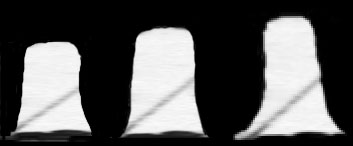 Figure
5. Cuspid 5 profiles created from the object's shadow with differing
assumptions on lighting geometry. From left to right, the profiles show
how the object would appear if the sun angle were 6, 7, and 8 degrees.
Squashing the object down into a more ordinary lunar shape requires assumptions
about the slope that appear unreasonable. A 6 degree sun elevation would
require a slope of the terrain of 5 degrees off the horizontal, given the
10.9 degree elevation of the sun above the horizon cited in the Lunar Orbiter
2 catalog. Such a 5-degree slope seems unusually steep for a region of
the moon that appears to be generally flat and featureless. (NOTE: The
diagonal lines running across the profiles are from a framelet boundary
that crosses the shadow in the original photograph.)
Figure
5. Cuspid 5 profiles created from the object's shadow with differing
assumptions on lighting geometry. From left to right, the profiles show
how the object would appear if the sun angle were 6, 7, and 8 degrees.
Squashing the object down into a more ordinary lunar shape requires assumptions
about the slope that appear unreasonable. A 6 degree sun elevation would
require a slope of the terrain of 5 degrees off the horizontal, given the
10.9 degree elevation of the sun above the horizon cited in the Lunar Orbiter
2 catalog. Such a 5-degree slope seems unusually steep for a region of
the moon that appears to be generally flat and featureless. (NOTE: The
diagonal lines running across the profiles are from a framelet boundary
that crosses the shadow in the original photograph.)
It must be noted that only Cuspid 5 appears to be on any appreciable downward slope at all; the rest of them seem to be located at the flat bottom of a shallow circular depression.Two of them (visible at the extreme top and bottom of the first image presented of the area and not been described here) even appear to be on slopes that face the sun, perhaps making their heights greater than what their shadows would suggest.
A more precise method for resolving the question of the slopes of the terrain would be a photometric analysis. But this Lunar Orbiter photograph was enhanced electronically by NASA to bring out the maximum amount of visible detail, as were all the Lunar Orbiter photographs. Unfortunately, this enhancement renders the photographs unsuitable for photometric analysis according to the NASA documentation. The raw image data might be useful for this purpose, but the magnetic tapes containing that data are not easily available and require special tape reading machines that have not been built since the 1960s. The existing data tapes and the machines capable of reading them are fast deteriorating. One individual I'm acquainted with who worked for NASA during the Lunar Orbiter program has been trying to interest NASA in a modest project to save the priceless scientific data on these old tapes. NASA to date has shown no interest.
We may have to wait until human astronauts or automated lunar rovers once again explore the surface of the moon to find out what the Cuspids really are. But if that happens, I think that any exploreres passing nearby the Cuspids will view a scene that might make the admittedly inexact reconstructions presented here seem pale in comparison.